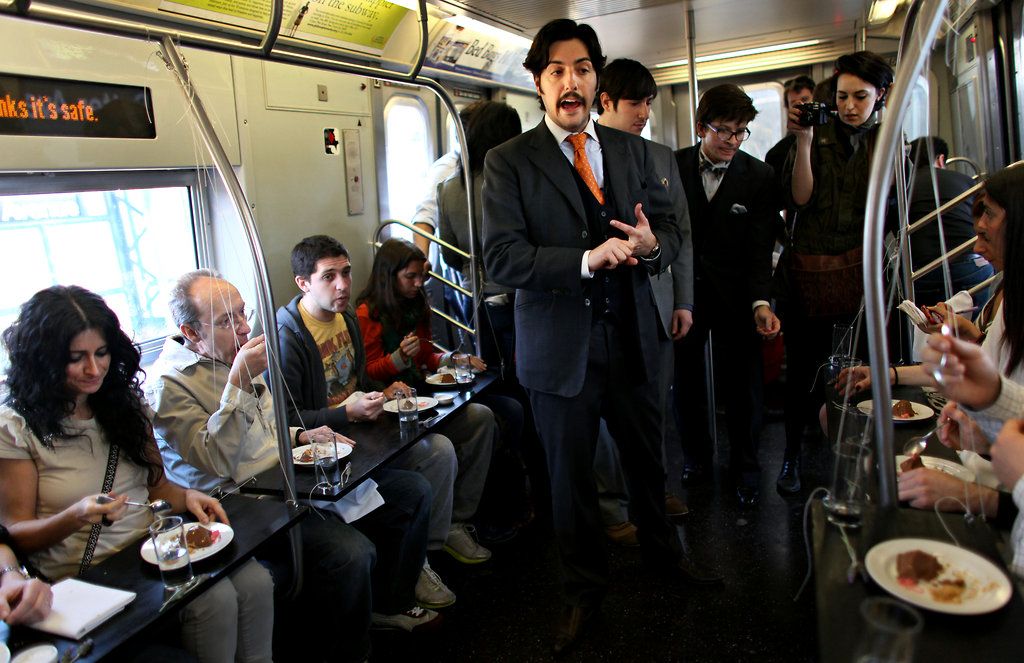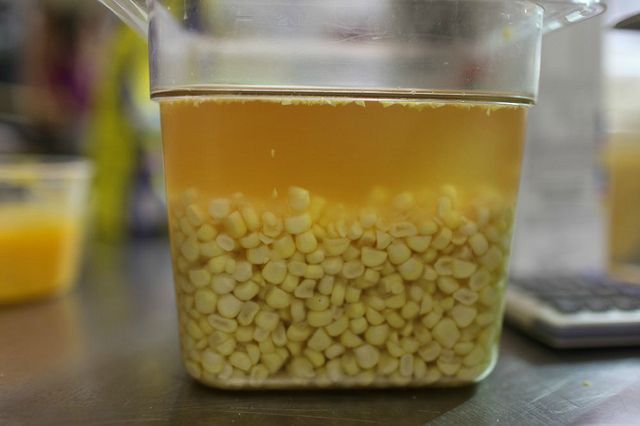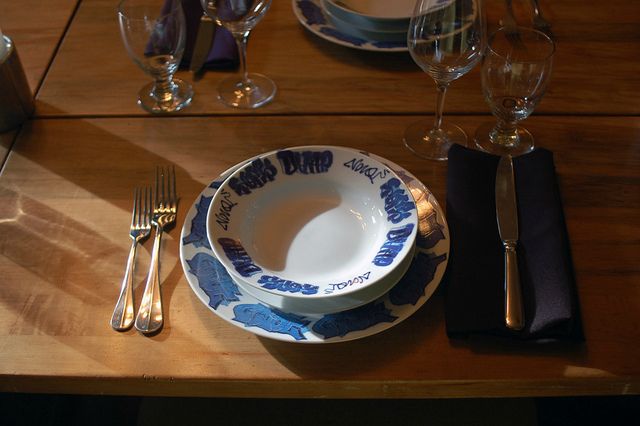We're sitting down with our favorite writers and cooks to talk about their upcoming cookbooks, their best food memories, and just about anything else.
Today: We talk to chef and artist Michael J Cirino about the love of collaboration and his group A Razor, A Shiny Knife.

Do you remember this New York Times article from last year about a group that turned a subway car into a full-service restaurant? That group was the "educational, social and theatrical culinary experience" known as A Razor, A Shiny Knife -- one part pranking group, one part performance art, and one part very skilled chefs, they are led by Daniel Castaño and Michael J Cirino. We spoke with Cirino about the group. Want to get involved in the next totally left-field idea they think up? Sign up for their mailing list!
1. How would you tell someone about A Razor, A Shiny Knife in four sentences or less?
It is a culinary performance arts group that hosts social, educational, and theatrical events around the world. These events take many shapes and forms, but they are all designed to create a unique environment around the preparation, service, and enjoyment of food. We hope our guests have a delicious and thought-provoking meal while meeting new interesting people, learning about the process or ingredients that are needed for the service of their meal, and participating in an experience that will leave them inspired. As artists, we enjoy creating a space where we can interact with our guests in ways that are just not possible in the confines of a restaurant or a typical home meal, and we create inspiration for ourselves by inspiring our guests.
2. Describe a few of your favorite events -- the luncheon on the L was a crowd favorite, but what are some others?

• King Corn: In 2010, the Corn Refiners Association lobbied the USDA to be able to change the name of corn syrup to "corn sugar." This created a wave of anger and frustration at the large farm conglomerates which led to movies like King Corn and people like Michael Pollan speaking out against this deception. I ended up equally frustrated, but more so amused. So we decided to host a meal where we fit as many different commercially available corn products as we could into one meal. A short list: corn meal, flour, starch, nixtamalized starch (masa), high fructose corn syrup, dextrose, maltose, matlodextrin, vinegar, oil, xanthan gum, among others in a long list of refined starches that we see on the sides of processed foods and drinks.

• The Black Banquet, London: I have long been enamored with black-colored food -- it creates a very unnatural feeling when not expected. So we used this concept to create a series of multi-course haute cuisine events in which every dish was devoid of color. This darkness on the plate was mirrored in the design, decor, staffing, and all other aspects of the evening. To create the performances for these events, we tapped into the dark and macabre nature of the host city, London.

• A Locally Sourced Meal: This meal was a part of the New York Food and Wine Festival. We sourced everything from within a 250-mile radius of NYC -- except for the food. The tables, chairs, silverware, china, glassware, flowers, artwork, and anything else that wasn't edible in the dining room was locally sourced, while all of the food was imported. The local craftsmen and artists were amazing to work with; their products are great and usually overlooked because of big-box retail stores. So in our way, we tried to remind people that if you buy your produce locally but take it home and cut it with Japanese knives, cook it in French pans, and serve it on plates and a table designed in Sweden and manufactured in China, you are missing your own point.
3. How do you brainstorm and find collaborators for your events?
Our whole existence, and my major passion in life, is collaboration and brainstorming. Our dinner parties started off as an excuse to convince interesting and exciting people to get into a room with us, so we could ask them questions, learn, and be inspired by them. The original invitees were in the culinary world, but quickly we discovered that food and our style of social cuisine attracted geniuses from all walks of life, so we happily expanded our questions and what we wanted to learn to adapt. It is this interaction between our current guests that becomes the basis for new and interesting productions in the future.
We are also focused on interacting with our community and finding out what is inspiring those of our guests who can only interact with us digitally. Our goal is to have ARASK be an organization that gets impossible or ridiculous ideas from the ether and turns them into reality at a very high resolution. Our doors are open for ideas and collaborators in any way that they find us.
If we have specific projects to work on, the process requires assembling a team of interested parties. This usually happens by me reaching to people with the kernel of an idea, or someone I know reaching out to me with an idea and me helping to build the team. Once we have a group of excited people around an idea, our initial goal is to make it as ridiculous as possible. If you set yourself with too many constraints, then you can start to stifle creativity. Once the idea is set in its absurdity, we take a break and come back to it in a few days, to reexamine what is actually possible or reasonable and who we could partner with to make it happen.
4. What is your advice for young, food-loving performance artists?
Cook with your friends. Do things with your friends. Have goals, even if they are small, because team building starts with becoming comfortable with each other. Once you are all comfortable, communication and excitement can flow much more easily. With those pathways open, creativity is never far behind.
Make lots of mistakes. Find ways to imagine and describe your ideas for yourself, for your team so that they are inspired, your partners so they think it is possible, and for your fans so they they think it is impossible.
5. What are you working on now?
Turn-taking. Smells. Ice sculpting. Lots of aero- and thermo-dynamics together. Jousting. Logistics. Robots. It is all pretty much robots and ball bearings. We are looking to expand a lot on the HOW portion of our guest experiences -- ie, "How did they do that?"

See what other Food52 readers are saying.